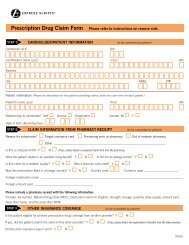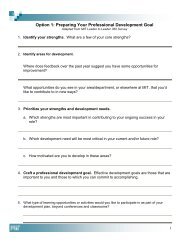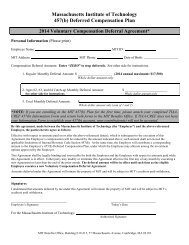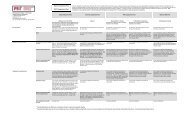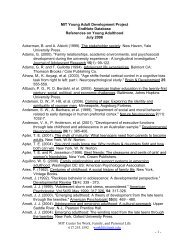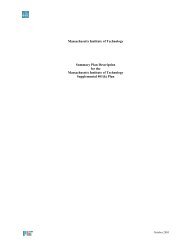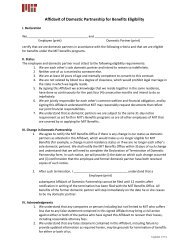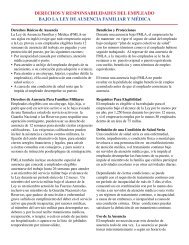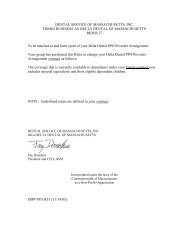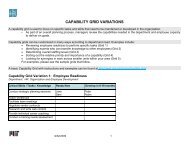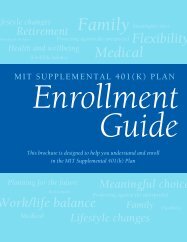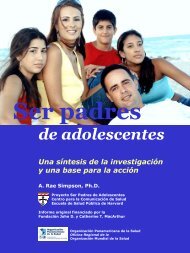Helping parents in developing countries improve adolescents' health
Helping parents in developing countries improve adolescents' health
Helping parents in developing countries improve adolescents' health
You also want an ePaper? Increase the reach of your titles
YUMPU automatically turns print PDFs into web optimized ePapers that Google loves.
Acknowledgements:<br />
The World Health Organization (WHO) thanks Rae Simpson of the Massachusetts<br />
Institute of Technology, for the preparation of the <strong>in</strong>itial draft of this document<br />
<strong>in</strong>corporat<strong>in</strong>g <strong>in</strong>puts from background papers, relevant publications and discussions<br />
dur<strong>in</strong>g the October 2006 WHO consultation. Appreciation is extended for the major<br />
contributions of Brian Barber, University of Tennessee, Krist<strong>in</strong> Mmari, Jen Bernste<strong>in</strong><br />
and Christ<strong>in</strong>a Fontecchio of the Bloomberg School of Public Health, Johns Hopk<strong>in</strong>s<br />
University. In addition, the follow<strong>in</strong>g <strong>in</strong>dividuals commented on and provided <strong>in</strong>put<br />
to drafts: Swati Bhave, Robert Blum, Doortje Braeken, Giovanna Campello, Matthews<br />
Chavunya, Shanti Conly, Mahua Mandal, Lucy Njoroge, Bame Nsamenang, Paul<strong>in</strong>e<br />
Russel Brown, and Danny Wight. The f<strong>in</strong>al draft was prepared by Jane Ferguson, WHO.<br />
Edit<strong>in</strong>g and layout was undertaken by Inís Documentation (www.<strong>in</strong>is.ie).<br />
WHO Library Catalogu<strong>in</strong>g-<strong>in</strong>-Publication Data<br />
<strong>Help<strong>in</strong>g</strong> <strong>parents</strong> <strong>in</strong> develop<strong>in</strong>g <strong>countries</strong> <strong>improve</strong> adolescents’ <strong>health</strong>.<br />
1.Adolescent <strong>health</strong> services. 2.Adolescent development. 3.Health behaviour. 4.Parent-child relations. 5.Parent<strong>in</strong>g.<br />
6.Parents. 7.Develop<strong>in</strong>g <strong>countries</strong>. I.World Health Organization.<br />
ISBN 978 92 4 159584 1 (NLM classification: WA 330)<br />
© World Health Organization 2007<br />
All rights reserved. Publications of the World Health Organization can be obta<strong>in</strong>ed from WHO Press, World Health<br />
Organization, 20 Avenue Appia, 1211 Geneva 27, Switzerland (tel.: +41 22 791 3264; fax: +41 22 791 4857; e-mail:<br />
bookorders@who.<strong>in</strong>t). Requests for permission to reproduce or translate WHO publications – whether for sale or for<br />
noncommercial distribution – should be addressed to WHO Press, at the above address (fax: +41 22 791 4806; e-mail:<br />
permissions@who.<strong>in</strong>t).<br />
The designations employed and the presentation of the material <strong>in</strong> this publication do not imply the expression of any<br />
op<strong>in</strong>ion whatsoever on the part of the World Health Organization concern<strong>in</strong>g the legal status of any country, territory, city<br />
or area or of its authorities, or concern<strong>in</strong>g the delimitation of its frontiers or boundaries. Dotted l<strong>in</strong>es on maps represent<br />
approximate border l<strong>in</strong>es for which there may not yet be full agreement.<br />
The mention of specific companies or of certa<strong>in</strong> manufacturers’ products does not imply that they are endorsed or<br />
recommended by the World Health Organization <strong>in</strong> preference to others of a similar nature that are not mentioned. Errors<br />
and omissions excepted, the names of proprietary products are dist<strong>in</strong>guished by <strong>in</strong>itial capital letters.<br />
All reasonable precautions have been taken by the World Health Organization to verify the <strong>in</strong>formation conta<strong>in</strong>ed <strong>in</strong> this<br />
publication. However, the published material is be<strong>in</strong>g distributed without warranty of any k<strong>in</strong>d, either expressed or implied.<br />
The responsibility for the <strong>in</strong>terpretation and use of the material lies with the reader. In no event shall the World Health<br />
Organization be liable for damages aris<strong>in</strong>g from its use.<br />
Photo credits:<br />
Cover: Tamari (Nomsa Mlambo) with her mother Ketiwe (Peligia Viaji). Video still from “Everyone’s Child,” a movie about<br />
orphaned children (© 1992 Media for Development International, Courtesy of Photoshare).<br />
Page 9: Thandi is consoled by her mother after a long talk about teenagers and condoms <strong>in</strong> the film “More Time,” a movie<br />
set <strong>in</strong> Zimbabwe about adolescent love, sexuality, and the danger of AIDS. In this scene, Thandi’s mother talks with her<br />
daughter after f<strong>in</strong>d<strong>in</strong>g condoms <strong>in</strong> Thandi’s bedroom drawer (© 1993 Media for Development International, Courtesy of<br />
Photoshare).<br />
Page 13: An adolescent Kikuyu girl <strong>in</strong> Nairobi, Kenya (© 2001 Sammy Ndwiga, Courtesy of Photoshare).<br />
Page 24, 28: Source: ’Good Parent<strong>in</strong>g Calendar’ produced by JA-STYLE, Jamaica’s Solution to Youth Lifestyle and<br />
Empowerment (USAID Contract No. 532-C-00-05-00029-00), managed by University Research Co., LLC (URC) with<br />
subcontractor, Advocates for Youth.<br />
Pr<strong>in</strong>ted <strong>in</strong>



